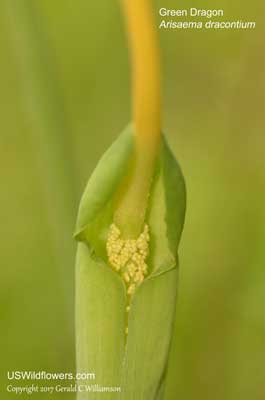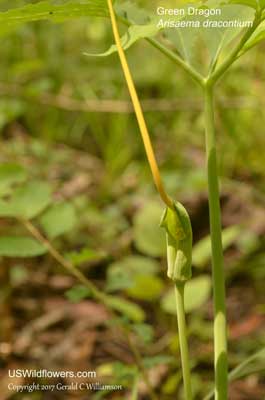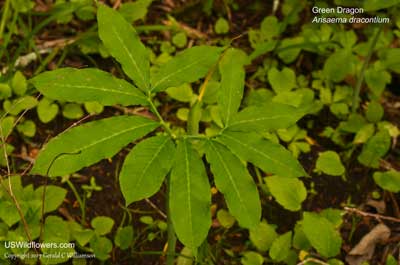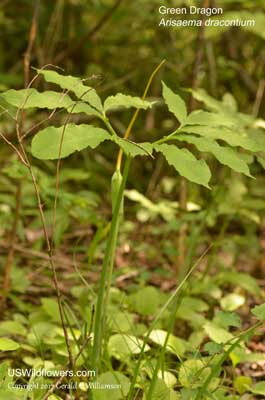Green Dragon, Dragonroot - Arisaema dracontium
|
Arisaema dracontium - Green Dragon, Dragonroot. While there are around 170 species of Arisaema in the world, there are only 2 to 6 in the United States, the number depending on whether you subscribe to treating Arisaema triphyllum broadly, with a number of different subspecies, varieties, and forms, or, as seems to be the trend lately to treat these as separate species. In any case, there is no dispute that the other U.S. Arisaema - Green Dragon - is a distinct species, Arisaema dracontium.
A. dracontium is a relatively rare plant of moderately moist to wet woodlands and thickets in most of the eastern half of the United States, although it is absent from Maine and Rhode Island. It usually flowers in spring and early summer, although in Mexico it may bloom in late winter.
As with all members of Araceae, ingesting uncooked plants (all parts) can cause significant distress - irritation and swelling of lips, tongue, and throat.
Found in:
AL, AR, CT, DC, DE, FL, GA, IA, IL, IN, KS, KY, LA, MA, MD, MI, MN, MO, MS, NC, NE, NH, NJ, NY, OH, OK, PA, SC, TN, TX, VA, VT, WI, WV, GS
Leave comments on Arisaema dracontium at this link. | 
Distribution of Arisaema dracontium in the United States and Canada:

Blue=Native; Grey=Introduced
Map from USDA Plants Database:
USDA, NRCS. 2017. The PLANTS Database (http://plants.usda.gov, 16 Jan 2025). National Plant Data Team, Greensboro, NC 27401-4901 USA.
Search Our Database: Enter any portion of the Scientific, Common Name, or both.
Do a general Google search of the entire site:
#ad
 Follow USWildflowers on Twitter
#ad
| | Site: Couchville Cedar Glade, Davidson County, TN Date: 2017-May-11 | Photographer: Gerald C Williamson
Nikon D7000 | | Arisaema dracontium is the only member of Arisaema in the United States with the spadix normally elongated to reach outside the enclosing green spathe. While the spathe is usually no longer than 2.5 inches (rarely up to 5 inches on larger plants), the spadix with its long slender appendage can be easily a foot long, rising above the leaves. | | 
| | Site: Couchville Cedar Glade, Davidson County, TN Date: 2017-May-11 | Photographer: Gerald C Williamson
Nikon D7000 | | The flowers of Green Dragon are found on the spadix, hidden in the spathe, although more readily visible than on members of the Arisaema triphyllum complex. As with all members of Arisaema, a single plant may contain only staminate (male), pistillate (female), or both flowers. If it has both, the staminate flowers are above the pistillate flowers on the spadix. A single plant may change which type of flower it carries from year to year. | | Click on the photo for a larger image

| | Site: Couchville Cedar Glade, Davidson County, TN Date: 2017-May-11 | Photographer: Gerald C Williamson
Nikon D7000 | | The spathe is a light green, sometimes with purple markings. Unlike Arisaema triphyllum (et al), the spathe hood is not usually significantly distinguished from the spathe tube. Notice the split on the leaf stem behind the flower stalk - the stem appears to support two leaves, although this is really the split in the two-part single leaf on the plant. | | Click on the photo for a larger image

| | Site: Couchville Cedar Glade, Davidson County, TN Date: 2017-May-11 | Photographer: Gerald C. Williamson
Nikon D7000
Tamron SP 90MM f/2.8 AF Macro | | The single leaf (sometimes 2, rarely 3) of Arisaema dracontium is a compound leaf with two branching axes to either side of the stem. These axes curve, 5 to 21 (usually no more than 13) leaflets are attached to the outside of the curve. This leaf structure, which may be up to 20 inches long, is one of the most obvious identifying characteristics of Green Dragon. | | Click on the photo for a larger image

| | Site: Couchville Cedar Glade, Davidson County, TN Date: 2017-May-11 | Photographer: Gerald C Williamson
Nikon D7000 | | The leaf petiole is up to 2 feet tall, but the flower stem holding the spathe, spadix, and flowers is usually about 6 to 12 inches tall, not including the flowering structure, so the spathe is usually hidden below the leaves. The petiole and flower stem arise from a common sheath at the base, not shown in any of my photos. | | Click on the photo for a larger image

|
References used for identification and information:
|
|
| |
| #ad
|
|







